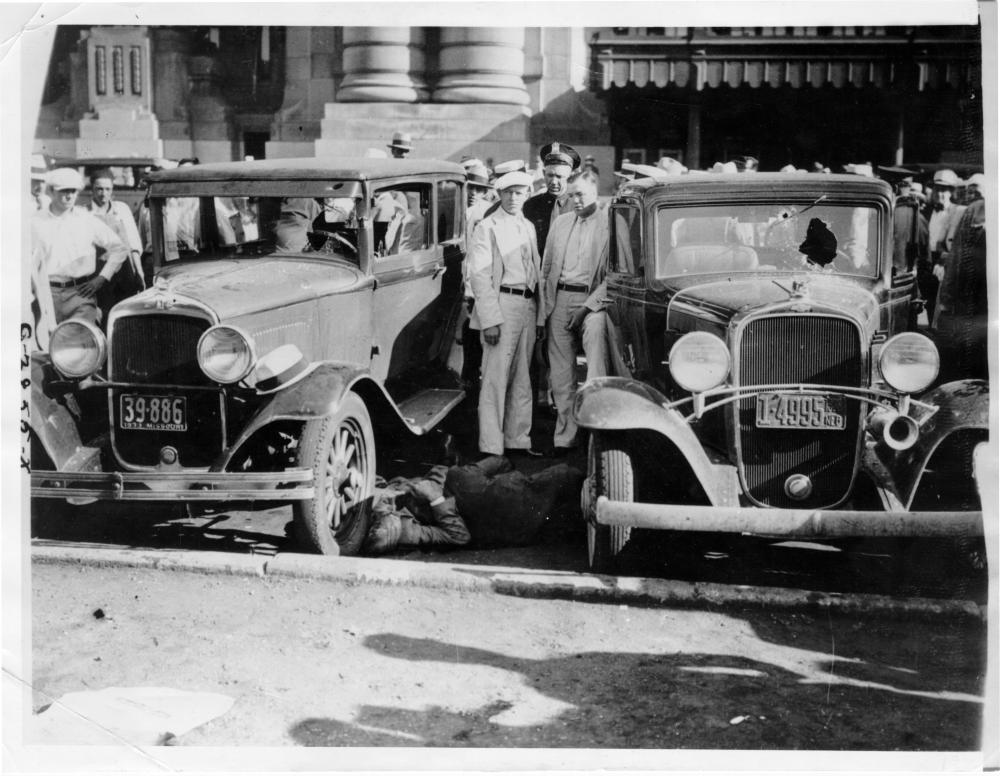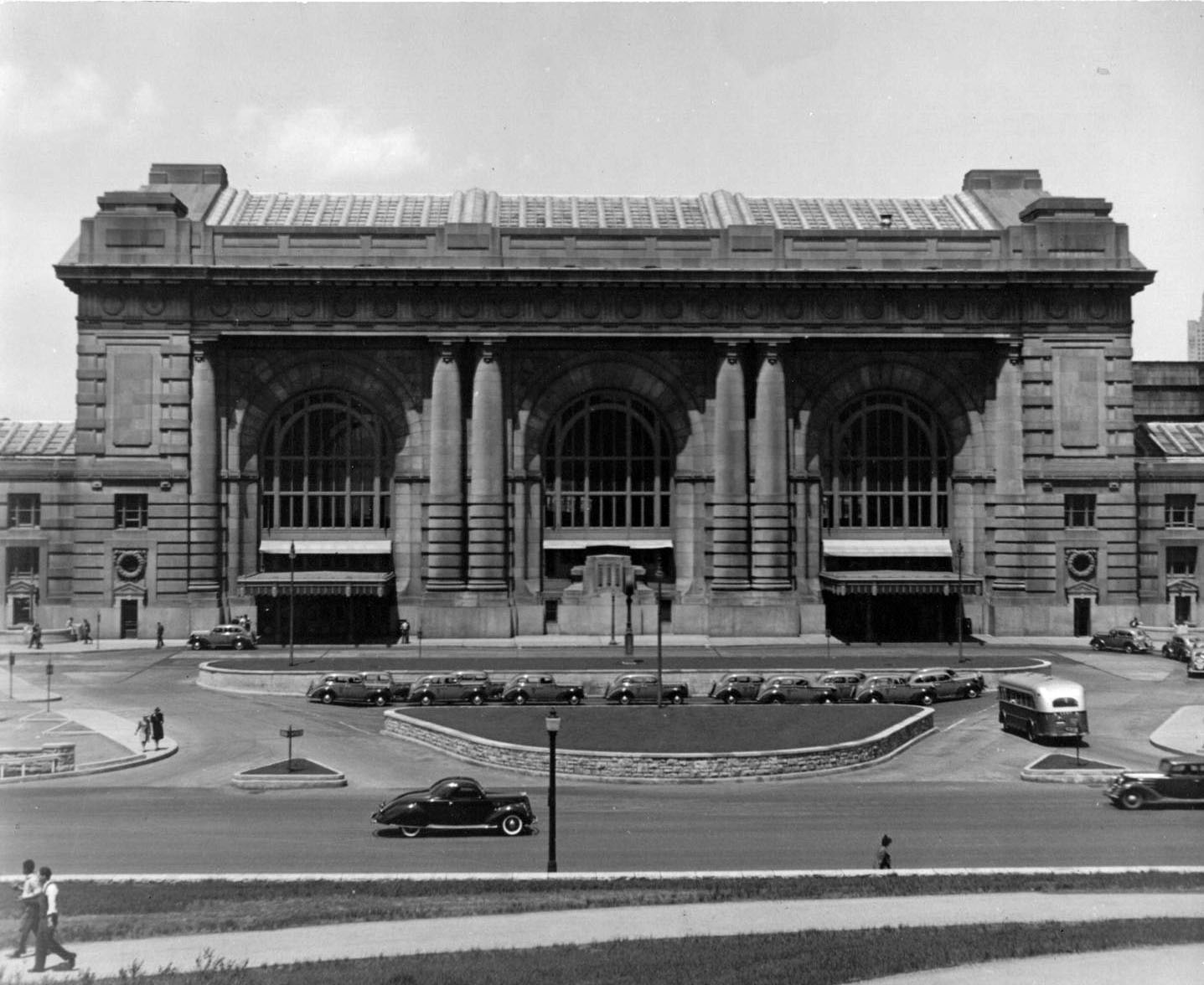A Mess of a Massacre
On June 17, 1933, four law enforcement officers and their prisoner, Frank Nash, were fatally wounded in a botched rescue attempt outside Union Station. The story of the Union Station Massacre, as it became known, centered on Frank Nash, who had been convicted of three separate crimes of a serious nature: murder, armed burglary, and then assault. Thanks to his ties to the criminal underworld, however, his associates were able to arrange pardons for the first two crimes. After serving six years in prison for the third, he escaped from the United States Penitentiary in Leavenworth, Kansas in October, 1930.
On June 16, 1933, the police chief of McAlester, Oklahoma and two agents of the U.S. Bureau of Investigation (renamed the Federal Bureau of Investigation in 1935) arrested him in Hot Springs, Arkansas. A third federal agent met them and they departed with Nash on a Missouri Pacific train bound for Kansas City. The next morning, they arrived at Union Station. Two more federal agents and two Kansas City Police Department officers were waiting to help transport the prisoner.
Just after several of the officers and Nash loaded into a Chevrolet car, a voice echoed through the parking lot: "Let 'em have it!." At least three gunmen immediately fired their machine guns on the unsuspecting officers. At the end of the shooting, four of the officers and Nash lay dead. After seeing that Nash had been killed, the gunmen fled.

It is unclear how the assailants knew about Nash's arrest and scheduled arrival in Kansas City on June 17, but many observers have suspected that Kansas City gangster John Lazia played a role in the massacre. The leader of Kansas City's criminal underworld, Lazia also held sway over the votes of the North Side, which allowed him to maintain close ties to Kansas City political "boss" Tom Pendergast and city manager Henry McElroy.
Lazia gained virtual control of the police department through bribery and by effecting the hiring of criminals as policemen. His operatives occasionally served as a police force entirely separate from the official one. Given Lazia's strong ties to the police, it was entirely possible that he or his operatives learned of Nash's arrest through the police department, arranged the attempted rescue of Nash, and then helped the attackers escape the city.
Equally likely, historian Robert Unger argues that the federal agents bungled the secret transfer by telling details of the arrest to an Associated Press reporter. Indeed, just after midnight the morning edition of the Kansas City Star carried an AP article that detailed the arrest of Nash and announced that the agents were bringing him to Leavenworth by train. A simple glance at the newspaper around midnight would have made it clear that three federal agents would arrive in either Kansas City or Leavenworth later that morning. Still, no one knows for sure how the information reached the assailants or who made the plans for the rescue attempt.
It is more certain that fate was not kind to Lazia or the accused assailants at Union Station. Over the following months, Lazia's power faded as he accumulated enemies. In July 1934, unidentified men shot and killed Lazia on his driveway after he and his wife arrived home one evening. Meanwhile, Vernon Miller, a suspect in the Union Station Massacre, had been murdered near Detroit, Michigan in 1933. The police arrested Adam Richetti, the suspected shooter in the massacre, in Wellsville, Ohio after a shootout that followed a car accident in 1934. Richetti was tried, found guilty, and executed in 1938.
Charles Arthur "Pretty Boy" Floyd was in the same car accident and shootout as Richetti, but escaped. Two days later, police officers killed Floyd in another shootout near Clarkson, Ohio. Four other men were found guilty of conspiring in the plot, and each of them spent two years in prison and paid $10,000 fines.
A legacy of the massacre was the federal investigation that helped to establish the career of lead investigator J. Edgar Hoover, who became the first and longest-serving director of the FBI. The FBI accused Richetti and Floyd of participating in the massacre, even though their guilt has recently come into question by historians Michael Wallis and Robert Unger. It still remains unknown who the three gunmen were at Union Station on June 17, 1933. What is certain is that the criminals, murders, and machine politics tied to the Kansas City underworld during the 1930s gave the city a reputation for organized crime that, at least for a time, was second only to Chicago. Today, many claim that marks from the bullets fired at Union Station in 1933 can still be seen on an exterior wall of the building.

Read full biographical sketches or profiles of people and places associated with the Union Station Massacre and the criminal underworld in Kansas City; prepared for the Missouri Valley Special Collections, the Kansas City Public Library:
- Biography of John Lazia (1896-1934), crime figure, by Daniel Coleman.
- Biography of Henry Francis McElroy (1865-1939), City Manager, by Nancy J. Hulston.
- Biography of Thomas Pendergast (1873-1945), business owner and "political boss," by Susan Jezak Ford.
- Union Station Profile, by Susan Jezak Ford.
View images of people and places associated with the Union Station Massacre that are a part of the Missouri Valley Special Collections:
- Union Station Massacre Scene
- Union Station, 1930
- Union Station and City Skyline, 1920
- Union Station, 1938
- Union Station, interior view, 1935
Check out the following books, articles, and films about the Union Station Massacre held by the Kansas City Public Library:
- The Union Station Massacre: The Original Sin of J.Edgar Hoover’s FBI, by Robert Unger.
- Lawman to Outlaw: Verne Miller and the Kansas City Massacre, by Brad Smith.
- Triple Cross Fire!: J. Edgar Hoover & the Kansas City Union Station Massacre, by Larry R. Kirchner.
- Union Station, by Ande Parks and Eduardo Barreto.
- "Massacre Turned FBI into a Powerhouse," by Mark Morris in the Kansas City Star, June 16, 2008.
- Pretty Boy, by Michael Wallis; a biography of Charles Arthur "Pretty Boy" Floyd.
- False Faces on Quality Street: An Intimate Close-Up View of Political Intrigue, Scandal and Romance in the American City, with Its Daily Drama of Struggles and Pathos; Triumphs and Thrills, by David Milton Proctor; a 1937 fictional novel based in Kansas City between the late 1910s and the 1930s. Fictional events include an airport slaying that is inspired by the Union Station Massacre.
- "Kansas City Massacre," VHS, film editors Richard A. Harris, Dennis Virkler.
Continue researching the Union Station Massacre using archival material held by the Missouri Valley Special Collections:
- Vertical File: Union Station Massacre.
- Vertical File: Union Station Massacre; Ten Thousand Public Enemies; biographical sketches of the most infamous outlaws in Kansas City in the early 20th century.
- Vertical File: Lazia, John.
- Vertical File: Floyd, Charles "Pretty Boy"; Floyd was supposedly involved in the massacre.
References:
Henry C. Haskell, Jr., and Richard B. Fowler, City of the Future: A Narrative History of Kansas City, 1850-1950 (Kansas City, MO: Frank Glenn Publishing, 1950), 133.
Rick Montgomery & Shirl Kasper, Kansas City: An American Story (Kansas City, MO: Kansas City Star Books, 1999), 222.
Robert Unger, The Union Station Massacre: The Original Sin of J. Edgar Hoover’s FBI, (Kansas City, MO: Andrews McMeel Publishing, 1997), 36-50.


